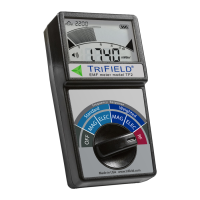required to induce that much current. However, biological reactions generally occur at speeds
that are slower than 1000 Hz, so on Weighted modes, the meter is designed to become less and
less sensitive at frequencies above 1000 Hz.
EMF EXPOSURE LIMITS
Many dierent EMF exposure limit standards have been published. Below is a table of some of
the published national and international standards. There are many variables that determine
the basis of these standards, including: EMF frequency, length of exposure, and aected body
part(s). One thing to note is that the IEEE and most Western European limits are based on the
thermal impact of EMF on the human body, whereas the Russian and Eastern European limits
focus more on dose over extended exposure periods. For more detail, the sources are listed
below.
Mains Electricity ( 50 Hz or 60 Hz) 2000 MHz (2 GHz)
Magnetic (mG) Electric (V/m) RF (mW/m
2
)
Russia
1
100 500 100
China
2
833 3333 400
ICNIRP
3,4
2000 4167 10,000
IEEE
5,6
9040 5000 10,000
[1] SanPiN 2.1.2.1002-00, Sanitary and epidemiological requirements for residential buildings and premises
[2] GB 8702-2014, Controlling limits for electromagnetic environment
[3] ICNIRP GUIDELINES FOR LIMITING EXPOSURE TO TIME-VARYING ELECTRIC AND MAGNETIC FIELDS (1HZ - 100 kHZ)
[4] ICNIRP GUIDELINES FOR LIMITING EXPOSURE TO TIME-VARYING ELECTRIC, MAGNETIC AND ELECTROMAGNETIC FIELDS (UP TO 300 GHZ)
[5] IEEE Std C95.6™-2002, IEEE Standard for Safety Levels with Respect to Human Exposure to Electromagnetic Fields, 0-3 kHz
[6] IEEE Std C95.1™-2005, IEEE Standard for Safety Levels with Respect to Human Exposure to Radio Frequency Electromagnetic Fields, 3 kHz to 300 GHz
Typical Home and Oce EMF Levels
The maximum exposure limits shown above are much higher than levels you would typically
encounter. Some authorities recommend much lower levels for long-term exposure, but as
yet there is no consensus on safe levels. Generally, when measuring homes or oces, only the
actual areas where people spend time (or where EMF-sensitive equipment is to be located) are
important. In the middle of a typical home or oce, magnetic eld is usually less than 5.0 mG,
electric eld is usually less than 20 V/m, and RF is usually less than 5.000 mW/m
2
.
6

